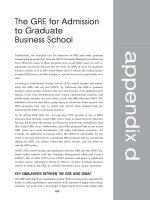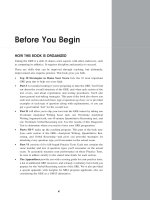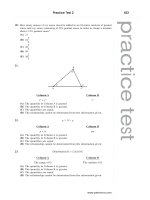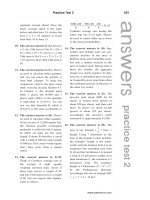Master Circular on SHG-Bank Linkage Programme ppt
Bạn đang xem bản rút gọn của tài liệu. Xem và tải ngay bản đầy đủ của tài liệu tại đây (58.5 KB, 7 trang )
Rural Planning & Credit Department Central Office, 10
th
Floor, Central Office Building, post box no. 10014 Mumbai -
400001
Tel No: 91-22-22661602 Fax No: 91-22-22621011/22610948/22610943 Email ID:
RBI/2012-13/87
RPCD. FID. BC.No. 04 / 12.01.033/ 2012-13 July 02, 2012
The Chairman/ Managing Director/
Chief Executive Officer
All Scheduled Commercial Banks
Dear Sir,
Master Circular on SHG-Bank Linkage Programme
The Reserve Bank of India has, from time to time, issued a number of
guidelines/instructions to banks on SHG-Bank Linkage Programme. In order to enable
the banks to have instructions at one place, a Master Circular incorporating the existing
guidelines/instructions on the subject has been updated and enclosed. This Master
Circular consolidates and updates the circulars issued by Reserve Bank on the subject
up to June 30, 2012 as indicated in the Appendix.
Yours faithfully
(C.D. Srinivasan)
Chief General Manager
Encl: As above
Master Circular on SHG-Bank Linkage Programme
1. Despite the vast expansion of the formal credit system in the country, the
dependence of the rural poor on moneylenders somehow continued in many
areas, especially for meeting emergent requirements. Such dependence was
pronounced in the case of marginal farmers, landless labourers, petty traders
and rural artisans belonging to socially and economically backward classes and
tribes whose propensity to save is limited or too small to be mopped up by the
banks. For various reasons, credit to these sections of the population had not
been institutionalized. The studies conducted by NABARD, APRACA and ILO on
the informal groups promoted by Non-Governmental Organizations (NGOs)
brought out that Self-Help Savings and Credit Groups had the potential to bring
together the formal banking structure and the rural poor for mutual benefit and
that their working had been encouraging.
2. Accordingly, NABARD launched a pilot project to cover Self-Help Groups
(SHGs) promoted by Non-Governmental Organizations, banks and other
agencies under the pilot project and supported it by way of refinance. The quick
studies conducted by NABARD in a few states to assess the impact of the
linkage project brought out encouraging and positive features like increase in
loan volume of the SHGs, definite shift in the loaning pattern of the members
from non-income generating activities to production activities, nearly 100%
recovery performance, significant reduction in the transaction costs for both the
banks and the borrowers etc, besides leading to gradual increase in the income
level of the SHG members. Another significant feature observed in the linkage
project was that about 85% of the groups linked with the banks were formed
exclusively by women.
3. With a view to studying the functioning of SHGs and NGOs for expanding their
activities and deepening their role in the rural sector, in November 1994, RBI
constituted a working Group comprising eminent NGO functionaries,
academicians, consultants and bankers under the Chairmanship of Shri S.K.
Kalia, the then Managing Director, NABARD. The Working Group was of the view
that the linking of SHGs with the banks is a cost effective, transparent and
flexible approach to improve the accessibility of credit from the formal banking
system to the unreached rural poor, which is expected to offer the much needed
solution to the twin problems being faced by the banks, viz recovery of loans in
the rural areas and the high transaction cost in dealing with small borrowers at
frequent intervals. The Group, therefore, felt that the thrust of the policy should
be to encourage the formation of SHGs and their linking with the banks and in
this regard, the banks have a major role to play. The Working Group had
recommended that the banks should treat the linkage programme as a business
opportunity and they may design area specific and group specific loan packages
taking into account inter alia the potential, local needs, available talent/skills etc.
4. The Reserve Bank constituted four informal groups in October 2002 to examine
various issues concerning micro-finance delivery. Linking of SHGs with banks
have been emphasized in the Monetary policy of Reserve Bank of India and
Union Budget announcements from time to time and various guidelines have
been issued to banks in this regard. To scale up the SHGs linkage programme
and make it sustainable, banks were advised that they may consider lending to
SHGs as part of their mainstream credit operations both at policy and
implementation level. They may include SHG linkage in their corporate
strategy/plan, training curriculum of their officers and staff and implement it as a
regular business activity and monitor and review it periodically.
5. Separate Segment under priority sector: In order to enable the banks to report
their SHG lending without difficulty, it was decided that the banks should report
their lending to SHGs and/or to NGOs for on-lending to SHGs/members of SHGs
under the new segment, viz. 'Advances to SHGs' irrespective of the purposes for
which the members of SHGs have been disbursed loans. Lending to SHGs
should be included by the banks as part of their lending to the weaker sections.
6. Opening of Savings Bank A/c: The SHGs registered or unregistered which are
engaged in promoting savings habits among their members would be eligible to
open savings bank accounts with banks. These SHGs need not necessarily have
already availed of credit facilities from banks before opening savings bank
accounts.
7. SHG lending to be a part of planning process: Bank lending to SHGs should
be included in branch credit plan, block credit plan, district credit plan and state
credit plan of each bank. While no target is being prescribed under SHG bank
linkage programme, utmost priority should be accorded to the sector in
preparation of these plans. It should also form an integral part of the bank’s
corporate credit plan.
8. Margin and Security Norms: As per operational guidelines of NABARD, SHGs
may be sanctioned savings linked loans by banks (varying from a saving to loan
ratio of 1:1 to 1:4). However, in case of matured SHGs, loans may be given
beyond the limit of four times the savings as per the discretion of the bank.
Experience showed that group dynamics and peer pressure brought in excellent
recovery from members of the SHGS. The flexibility allowed to the banks in
respect of margin, security norms, etc. under the pilot project continues to be
operational under the linkage programme even beyond the pilot phase.
9. Documentation: A simple system requiring minimum procedures and
documentation is a precondition for augmenting flow of credit to SHGs. Keeping
in view the nature of lending and status of borrowers, banks should strive to
remove all operational irritants and make arrangements to expeditiously sanction
and disburse credit by delegating adequate sanctioning powers to branch
managers. The loan application forms, procedures and documents should be
made simple. It would help in providing prompt and hassle-free credit.
10. Presence of defaulters in SHGs: The defaults by a few members of SHGs
and/or their family members to the financing bank should not ordinarily come in
the way of financing SHGs per se by banks provided the SHG is not in default to
it. However, the bank loan may not be utilized by the SHG for financing a
defaulter member to the bank.
11. Capacity Building and Training: An important step in the Linkage Programme
would be the training of the field level officials and sensitization of the controlling
and other senior officials of the bank. Considering the need and magnitude of
training requirements of bank officers/staff both at field level and controlling office
level, the banks may initiate suitable steps to internalize the SHGs linkage project
and organize exclusive short duration programmes for the field level
functionaries. In addition, suitable awareness/sensitization programmes may be
conducted for their middle level controlling officers as well as senior officers.
12. Monitoring and Review of SHG Lending: Having regard to the potential of the
SHGs, banks may have to closely monitor the progress regularly at various
levels. In order to give a boost to the ongoing SHG bank linkage programme for
credit flow to the unorganized sector, banks were advised in January 2004 that
monitoring of SHG bank linkage programme may be made a regular item on the
agenda for discussion at the SLBC and DCC meetings. It should be reviewed at
the highest corporate level on a quarterly basis. Further the progress of the
programme may be reviewed by the banks at regular intervals. A progress report
may be sent to NABARD (Micro Credit Innovations Department), Mumbai, on a
half-yearly basis, as on 30 September and 31 March each year so as to reach
within 30 days of the half-year to which the report relates.
13. Encourage SHG Linkage: Banks should provide adequate incentives to their
branches in financing the Self Help Groups (SHGs) and establish linkages with
them, making the procedures absolutely simple and easy while providing for total
flexibility in such procedures to suit local conditions. The group dynamics of
working of the SHGs may be left to themselves and need
neither be regulated
nor formal structures imposed or insisted upon.
The approach to financing of
SHGs should be totally hassle-free and may include consumption expenditures.
14. Interest rates: The interest rate applicable to loans given by banks to Self Help
Groups/member beneficiaries would be left to their discretion.
15. Total Financial Inclusion and Credit Requirement of SHGs: Banks have been
advised to meet the entire credit requirements of SHG members, as envisaged in
the Paragraph 93 of the Union Budget announcement made by the Honourable
Finance Minister for the year 2008-09 where in it was stated as under: "Banks
will be encouraged to embrace the concept of Total Financial Inclusion.
Government will request all scheduled commercial banks to follow the example
set by some public sector banks and meet the entire credit requirements of SHG
members, namely, (a) income generation activities, (b) social needs like housing,
education, marriage, etc. and (c) debt swapping".
***
Appendix
List of Circulars consolidated in the Master Circular
Sr.
No.
Circular No. Date Subject
1. RPCD.No.Plan.BC.13/PL-09.22/91/92 July 24,1991 Improving Access of Rural
poor to Banking- Role of
Intervening Agencies- Self
Help Groups
2. RPCD No.PL.BC.120/04.09.22/95-96 April 2,1996 Linking of Self Help Groups
with banks- Working Group
on NGOs and SHGs-
recommendations –Follow
up
3. DBOD.DIR.BC.11/13.01.08/98 February
10,1998
Opening of Savings bank
accounts in the name of
Self Help Groups(SHGs)
4. RPCD.PI.BC/12/04.09.22/98-99 July 24,1998 Linking of Self Help Groups
with Banks
5. RPCD.No.PLAN.BC.94/04.09.01/98-99 April 24,1999 Loans to Micro Credit
Organizations- Rates of
Interest
6. RPCD.PL.BC.28/04.09.22/99-2000 September
30,1999
Credit delivery through
Micro Credit Organizations/
Self Help Groups
7. RPCD.No.PL.BC.62/04.09.01/99-2000 February
18,2000
Micro credit
8. RPCD.No.Plan.BC.42/04.09.22/ 2003-04 November
03,2003
Micro Finance
9. RPCD No.Plan.BC.61/04.09.22/2003-04 January
09,2004
Credit flow to the
unorganized sector
10. RBI/385/2004-05,
RPCD.No.Plan.BC.84/04.09.22/2004-05
March 03,2005 Submitting progress report
under micro credit
11. RBI/2006-07/441
RPCD.CO.MFFI.BC.No.103/12.01.01/2006
-07
June 20,2007 Microfinance-Submission of
progress reports
12. RPCD.MFFI.BC.No.56/12.01.001/2007-08 April 15,2008 Total Financial inclusion
and Credit Requirement of
SHGs.









